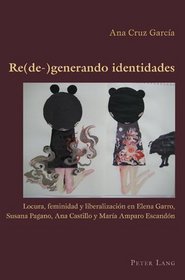Book Launch: Ana Cruz García

Re(de-)generando identidades:
Locura, feminidad y liberalización en Elena Garro, Susana Págano, Ana Castillo y María Amparo Escandón
by Dr Ana Cruz Garcia
This book examines the figure of the madwoman in four novels, two Mexican and two Mexican-American, published in the 1990s. The ubiquitous presence of the madwoman in Mexican culture has not passed unnoticed; indeed, at the beginning of the twenty-first century the writer Edmée Pardo talks about the so-called imaginario de la enfermedad to refer to the ever-present images of sick women, namely the madwoman, in Mexican women’s literature. However, to date there is no critical study that explores the relevance of this presence and/or its different manifestations. This book aims to fulfil this critical gap and also explore the difficulties that women writers still face when trying to liberate their female protagonists. Thus, whilst all the texts coincide in presenting the madwoman as a figure of rupture with behaviours and spaces traditionally associated with the feminine, the methods employed to construct this figure respond to two different conceptions of madness. In Garro and Págano, the madwoman largely corresponds to the concept of the abject that Julia Kristeva presents in her ground-breaking book, Powers of Horror. The madwoman is presented as a fragmented being which, in attempting to escape from an oppressive patriarchal system, ends up destroyed/abjected by that same order. However, in Castillo and Escandón she is constructed in a more positive and visionary way, more in accordance with the idea of the New Mestiza that Gloria Anzaldúa develops in her writing Borderland/La frontera. Thus, the madwoman is presented as a more superior and rational being and madness represents a journey towards darkness which is nevertheless necessary in order to reach clarity and completeness.
About the author....
Ana Cruz Garcia obtained a BA in English at the University of Granada, Spain and subsequently she completed an MA and PhD in Hispanic Studies at University College Cork. She worked as Language Assistant in Mount Royal College, Canada (1999-2000) and was awarded the Irish Research Council for Humanities and Social Sciences scholarship in 2004-2006. Currently, she is working as Assistant Lecturer in Cork Institute of Technology and is a member of the Centre of Mexican Studies in University College Cork.
Re(de-)generando identidades: Locura, feminidad y liberalización en Elena Garro, Susana Pagano, Ana Castillo y María Amparo Escandón.
Este libro examina la figura de la loca en cuatro novelas publicadas en los años noventa, dos mexicanas y dos mexicano-americanas. La presencia ubicua de la loca en la cultura mexicana ha sido desde siempre destacada y, por ejemplo, la escritora Edmée Pardo a principios del siglo XXI habla del llamado imaginario de la enfermedad para referirse a la omnipresencia de mujeres enfermas, principalmente la loca, en la literatura mexicana producida por mujeres. Sin embargo, hasta ahora no existe ningún estudio crítico que explore la relevancia de esta presencia y/o sus diferentes manifestaciones. Este libro intenta llevar dicho vacío crítico al mismo tiempo que también explora las dificultades a las que las escritoras aún se enfrentan para crear protagonistas liberalizadas e independientes. Mientras que todos los textos presentan a la loca como una figura de quiebra contra comportamientos y espacios tradicionalmente asociados a lo femenino, los métodos empleados para llevar a cabo tal tarea responden a dos concepciones diferentes de la locura. En Garro y Págano, la representación de la loca se atiene al concepto de lo abyecto que presenta por Julia Kristeva en su obra Powers of Horror. Es un ser fragmentado que al intentar escapar de un orden patriarcal asfixiante acaba siendo destruida por ese mismo sistema. Sin embargo, en Castillo y Escandón la loca es construida en términos positivos y visionarios, más en relación con la idea de la Nueva Mestiza que Gloria Anzaldúa desarrolla en Borderland/La frontera. La loca es así presentada como un ser superior y racional y la locura como una viaje hacia una oscuridad que es, no obstante, necesaria para poder alcanzar posteriormente una claridad absoluta.
About the author....
Ana Cruz García es licenciada en Letras en la Universidad de Granada en España. Obtuvo su Máster y Doctorado en la Universidad de Cork, en Irlanda. Fue lectora en Mount Royal College, Calgary, Canadá (1999–2000) y becaria del Irish Research Council for Humanities and Social Sciences (2004–2006). Actualmente, trabaja como Assistant Lecturer en la Institut de Tecnología de Cork y es miembro del Centre of Mexican Studies de la misma universidad.
Centre for Mexican Studies
Contact us
Room 1.51, First Floor - Block B East, O'Rahilly Building, University College Cork Ireland
